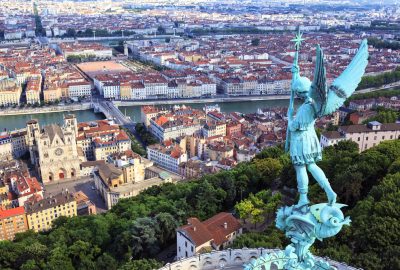Paris might best known as the city of love and lights. But France’s second largest city; Lyon is widely recognized as the birthplace of gourmet food. It is the cradle of the famous French cuisine, which many consider the cornerstone of modern cooking. Lyon stands on ruins of a 1st century BC Roman city: Lugdunum which used to be a local centre nicknamed “The Capital of the Three Gauls”. You most likely heard the term before while watching Asterix and Obelix cartoons. Remnants of that former glory are still standing and available for public viewing, even public sitting upon. Basilica of Notre-Dame de Fourvière stands on top of an ancient Roman forum and was built as a monument to the cities survival of the Black Death, which is celebrated annually in December during a festival called Fête des Lumières. The basilica is situated on a hill from which you can view the entire city; sometimes they even open one of the towers to visitors for an even greater vista. Ruins of Lugdunum is another area where you can literally walk on ancient history, the city was an important asset to Rome and was frequently visited by the emperors, some were even born there. A theatre is still standing and functions during summer months, it’s an incredible site even for modern times, it had seats for an audience of over 10,000 people.
Modern Lyon isn’t a city for people that value their privacy; it’s a labyrinth of tiny alleys and staircases. Not only it’s a nightmare to navigate but also you can’t turn your head in any direction without looking into someone’s apartment. Lyon is not only a horizontal maze but also vertical, getting from one street to another is often via steep stairs. It’s especially painful during tourist season when they should implement some kind of traffic lights. Those secret passages are called traboules and were used to protect silk shipments from the weather. Lyon used to be the silk-weaving capital of France, you can learn more about that in one the museum such as La Maison des Canuts (https://maisondescanuts.fr/). Place Bellecour is one of the few areas that don’t feel like a coffin, it’s the main square in Lyon and it used to function as a market with an added benefit of holding public executions on boring weekends. It’s overlooked by a stunning town hole, the historic administrative centre of Lyon. The Confluence Neighbourhood stands in contrast to all that history. It looks like the city of the future and is one of the largest urban development projects in Europe. Luxury apartments, shopping malls, and the riverbank are brimming with life; everything is designed with modern, environment-friendly technology. Make sure to visit Musée des Confluences; it combines a science centre with an anthropology museum, kind of like Lyon itself.

An equestrian statue of King Louis XIV at Place Bellecour looking at the Basilica of Notre-Dame de Fourvière
Enough of all that exploration, let’s eat! I could eat a horse after a day full of strolling around and Lyon is the perfect place to eat to your hearts’ content. How about eating WHILE sightseeing? There are more restaurants and food stands than trash bins in Lyon, nineteen of them decorated with prestigious Michelin Stars. Only one of them deserved the ultimate trophy of 3 stars, it’s located on 40 Rue de la Plage and was established by the late Paul Bocuse who named it quite humbly: The Auberge. Restaurants like that are in a league of their own and justify a trip to Lyon just for the food. Bocuse was old school. He didn’t reinvent the wheel but used his grandmas’ recipes. He only worked with top quality ingredients and wore a funny chef hat. Bocuse was a true host and used to greet his guests and make sure everything was crafted to their liking. I feel like modern chefs are trying to copy that style of running a restaurant but it often comes off as fake. Paul Bocuse was such a legend, a symbol and an ambassador of French cuisine that one of the most prestigious food markets in the world is named after him. Les Halles Paul Bocuse (https://www.halles-de-lyon-paulbocuse.com/) at 102 Cours Lafayette is a staple for traveling gluttons like me, give it a try. I imagine Lyon is where chefs go on vacation.




No one commented yet. Be the first.